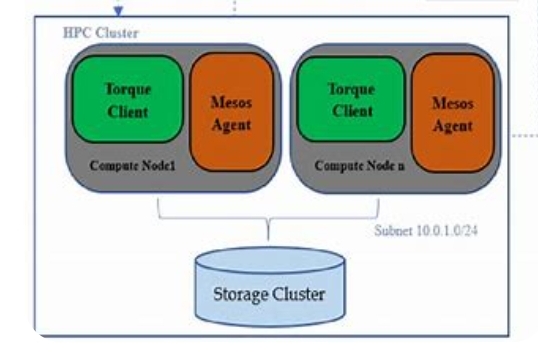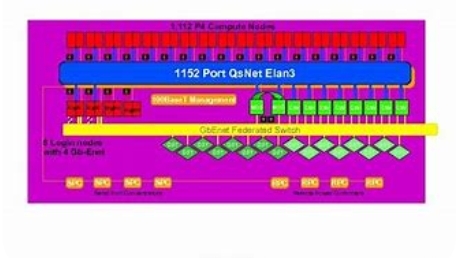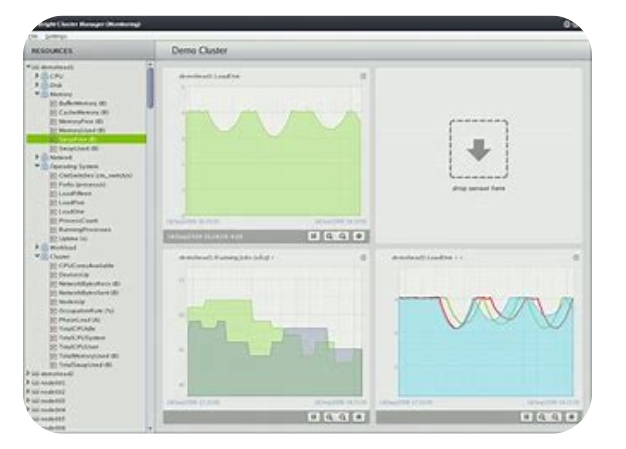HPC stands for High-performance computing (HPC). This refers to a computing system which is made up of many interconnected computers (nodes) working together to carry out more complex calculations and tasks. These clusters are employed in solving large and complex problems that require much computing power and resources, such as modeling weather patterns, simulating chemical reactions, and analyzing large volumes of data.

HPC cluster Linux usually includes a head node that acts as the valuable manipulate point for the whole cluster and multiple compute nodes that do the bulk of the processing. The pinnacle node manages the scheduling of tasks and distributes workloads to the compute nodes. The compute nodes are normally excessive-performance servers which are optimized to handle processor-intensive responsibilities.
HPC cluster Linux frequently runs on open-source software programs and is incredibly customizable, allowing companies to tailor their computing surroundings to their specific desires. This adaptability makes HPC cluster Linux a famous preference for scientific research, engineering, and different fields that require complicated simulations and statistics processing.
Overall, HPC cluster Linux offers an effective computing environment that allows agencies to tackle some of the most complicated and hard issues facing cutting-edge science and engineering.
YOU CAN ALSO: 802.1X AUTHENTICATION: THE MAJOR KEY TO NETWORK SAFETY”.
Setting up HPC Cluster Linux
Setting up an HPC cluster in Linux can be a tough and demanding task if you don’t know how to properly do it. But don’t worry, in this section we are going to show you a step-by-step guide in setting up HPC cluster Linux. Below are the steps you should follow to properly set up HPC cluster Linux.
- choose your hardware: you may need to pick out the hardware you may use for the HPC cluster, which include servers, switches, and garage devices. make certain the hardware is compatible with Linux.
- install the Linux running device: as soon as you have got your hardware, deploy the Linux working device on every server. There are several distributions to select from, inclusive of Ubuntu, CentOS, and red Hat.
- Configure the network: Configure the network in order that each server can speak with the others. set up a committed community for the cluster to avoid any interference from other visitors.
- install and configure an activity scheduler: A job scheduler is used to manipulate the workload on the cluster. popular job schedulers encompass Torque and SLURM. set up the process scheduler on the top node and configure it to manage the resources of the cluster.
- install and configure MPI: MPI (Message Passing Interface) is well known for parallel programming. installation and configure MPI on every server within the cluster to permit for distributed computing.
- installation shared garage: Shared storage permits the servers inside the cluster to get admission to the equal data. This could be accomplished by the usage of network record structures which include NFS, or with shared garage devices like SAN or NAS.
- check the cluster: as soon as the HPC cluster is installed, check it to ensure the entirety is operating correctly. Run benchmarks and applications to assess the overall performance of the cluster.
- monitor and keep the cluster: everyday protection is necessary to ensure the cluster runs easily. screen the device health, replace software programs and hardware, and optimize the overall performance of the cluster.
Overall, putting in place an HPC cluster in Linux can be a complicated matter. However Following those steps will assist you get begun, however it’s essential to have a strong expertise of Linux and HPC ideas to make certain a successful implementation.
Linux-based HPC Cluster Architecture

There are several components that made up Linux-based HPC Cluster Architecture.
Here are those cocomponents.
- Compute Nodes: those are the principle processing units that carry out the real computations. They commonly run a lightweight Linux OS and are linked to every other through a devoted community.
- community: A excessive-velocity interconnect is wanted to make sure rapid conversation between the compute nodes. commonly, a low-latency and excessive-bandwidth community consisting of Infiniband is used.
- : HPC clusters need fast and dependable garage to preserve large quantities of facts. this may be furnished by means of a parallel file machine which includes Lustre or GPFS, or through storage place network (SAN) generation.
- Head Node: that is the primary control node that controls the whole cluster. It usually runs a full Linux OS along with software program tools including task schedulers, workload managers, and community management software program.
- Cooling: understand that HPC clusters generate a whole lot of heat, this is because of the high density of the compute nodes. Green cooling structure such as air condition or liquid cooling is very important to help preserve the clusters and also safe hard ware from getting harmed.
- strength: HPC clusters requires a whole lot of power to run, so an uninterrupted power supply is needed to keep it running. Also ensure to have proper energy backup Incase the primary source is down.
Managing HPC Cluster Nodes in Linux

In this section, we are going to talk about some of the core aspects of managing HPC cluster nodes in Linux.
1. Provisioning HPC Cluster Nodes
Provisioning refers to the technique of putting in place new node hardware. while building an HPC cluster, Linux is the most popular operating device of preference. consequently, the provisioning of new nodes commonly begins with installing a Linux OS (Ubuntu, CentOS, Debian, OpenSUSE, and many others.). once the set up is complete, system directors will configure networking, add SSH keys, and enable remote get admission to to the new nodes.
2. monitoring HPC Cluster Nodes
tracking is critical in handling HPC cluster nodes. It includes monitoring and analyzing system overall performance statistics, including CPU utilization, reminiscence utilization, disk utilization, network visitors, and others. machine directors use tracking gear together with Nagios, Zabbix, and Ganglia to become aware of any troubles with the gadget and fasten them proactively.
3. Administering HPC Cluster Nodes
Administering HPC cluster nodes involves acting crucial responsibilities along with putting in software and updates, configuring the community, setting up faraway get admission to and security features, developing consumer money owed, and managing device assets. system directors use command-line equipment, scripts, and web interfaces to manipulate person nodes, groups of nodes, and the cluster as an entire.
4. Updating HPC Cluster Nodes
Updating HPC cluster nodes is necessary to preserve the gadget updated and at ease. gadget directors want to use OS updates, protection patches, and new software releases frequently. some HPC clusters permit for rolling updates, in which one node can be updated at a time without causing any downtime.
5. Scheduling HPC Cluster Nodes
Scheduling refers back to the process of assigning computing obligations to to be had nodes. HPC clusters use workload management software including Slurm, LSF, PBS, or Condor to distribute workloads to the to be had nodes within the cluster. depending at the workload, it’s miles feasible to specify runtime requirements inclusive of processor architecture, the variety of cores, and reminiscence necessities.
YOU CAN ALSO: DEFENDING YOUR DIGITAL REALM WITH TWO FACTOR AUTHENTICATION 001
Deploying Applications on HPC Cluster Linux.

There are some steps you would need to follow if you are deploying application on HPC cluster Linux. This step will ensure the maximum performance and stability. Below are the steps.
- the first step is to Make sure that the HPC cluster is nicely configured and has the important software program and hardware sources.
- The next step is to select the right software program development tools and compilers required for the particular software. those can also include MPI, OpenMP, and other parallel programming frameworks.
- The third step includes designing the software to be parallelized, disbursed, and optimized for the HPC cluster architecture. This consists of identifying the bottleneck regions of the code, rewriting the code if essential, and profiling the code for performance optimization.
- The fourth step is to assemble the application the usage of the right compiler flags and optimization settings. This guarantees that the software is optimized for the HPC cluster environment.
- The subsequent step is to check the utility on a small scale and against precise test cases. This allows identify ability utility-specific troubles that would arise at the HPC cluster.
- The final step is to deploy the application on the HPC cluster. This includes submitting a process to the job scheduler with the correct parameters, consisting of the variety of nodes, wide variety of processors, and memory necessities. once the activity is submitted, the activity scheduler assigns sources to the task and monitors its progress.
YOU CAN ALSO: HOW TO KEEP YOUR WI-FI SAFE WITH WPA AUTHENTICATION PROCESS
Security in HPC Cluster Linux

Security remains a vital aspects of any computer system, hence it is very important to properly protect the HPC cluster against any unauthorized access. The following are some of the security measures deployed in HPC Linux Cluster.
1. Use SSH keys for remote access: Secure Shell (SSH) keys are a way to authenticate users connecting to the cluster remotely. Instead of passwords, SSH keys use encryption keys to authenticate users and provide secure remote access.
2. Implement firewalls: Firewalls are software or hardware-based security systems that monitor and control traffic to and from the cluster. Firewalls can be customized to allow only necessary traffic, thus blocking any suspicious network activity.
3. Update your software regularly: Keeping your HPC cluster software up to date is important because hackers can easily exploit any vulnerability. Regularly update cluster software packages, including the operating system, system utilities, and applications.
4. Use encryption: HPC clusters often store sensitive data that needs to be protected. Encryption is a technique that turns readable information into unreadable ciphertext. Use encryption at rest and in transit to protect sensitive data.
5. Implement access control: Access control ensures that only authorized users have access to cluster resources. Apply strict permissions and access control policies to limit user access to specific files and folders.
6. Auditing and log management. Regularly review the activity logs of your HPC cluster to detect unusual or suspicious activity. Log data can be used to trace an attacker’s path and identify compromised systems. Make sure the logs are stored safely and for an appropriate length of time.
Conclusion
HPC cluster Linux is a computing system which is made up of many interconnected computers (nodes) working together to carry out more complex calculations and tasks. These clusters are employed in solving large and complex problems that require much computing power and resources, such as modeling weather patterns, simulating chemical reactions, and analyzing large volumes of data.






